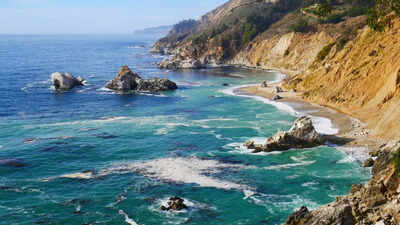ARTICLE AD BOX

Over 5 million years ago, the
Mediterranean Sea
underwent one of the most dramatic transformations in Earth’s history. During the
Messinian Salinity Crisis
, the sea largely dried up, leaving vast
salt flats
and gypsum deposits across the basin. The
Zanclean megaflood
refilled the Mediterranean in a catastrophic event triggered by the reopening of the
Strait of Gibraltar
. Atlantic waters surged into the desiccated basin at speeds and volumes unlike anything seen today, reshaping coastlines, carving underwater channels, and altering ecosystems. New
geological evidence
from Sicily and offshore imaging suggests that this flood may have refilled the sea in as little as two to sixteen years, transforming the region rapidly.
How Mediterranean Sea dried and again filled up
Between 5.96 and 5.33 million years ago, tectonic shifts and the closure of the connection to the Atlantic caused the Mediterranean to largely evaporate. Salt flats, gypsum deposits, and a desiccated seabed dominated the region. This extreme reduction in water volume created
hypersaline conditions
, severely affecting marine life and leaving the basin vulnerable to sudden changes once the Strait of Gibraltar reopened.The megaflood occurred when Atlantic waters rushed through the Strait of Gibraltar, creating discharge rates estimated between 68 and 100 million cubic meters per second. Fast, turbulent waters carved over 300 asymmetric erosional ridges across the Sicily Sill, flowing northeast into the eastern Mediterranean basin. The flood’s force reshaped underwater topography, forming channels, canyons, and ridges, leaving a permanent imprint on the region’s geological structures.
Geological evidence: Clues from Sicily and the Gulf of Cadiz
Researchers discovered breccia deposits, deformation structures, and a buried erosional channel extending from the Gulf of Cadiz to the Alboran Sea. Southeastern Sicily’s hills and depressions reveal signs of violent water flow, while offshore imaging confirms extensive erosion patterns. Together, these findings confirm the megaflood’s immense scale and sudden onset, supporting a rapid refilling scenario rather than a gradual process over thousands of years.
Environmental and ecological consequences
The Zanclean megaflood not only refilled the Mediterranean but also reshaped ecosystems. The sudden influx of water restored marine habitats, altered salinity levels, and likely triggered seismic activity and tropical-storm-force winds. This dramatic environmental shift allowed marine life to recolonize the basin, laying the foundation for the biodiversity observed in the Mediterranean today.
A lasting imprint on Earth’s history
The Mediterranean megaflood stands as one of the largest catastrophic floods in geological history. By rapidly transforming a near-desiccated sea into a fully replenished basin, it reshaped coastlines, ecosystems, and underwater landscapes. Modern studies of sedimentary layers,
erosional features
, and computer modeling continue to reveal the Zanclean megaflood as a striking example of how sudden geological events can radically alter the planet’s surface.



.png)
.png)
.png)
















 1 day ago
2
1 day ago
2








 English (US) ·
English (US) ·